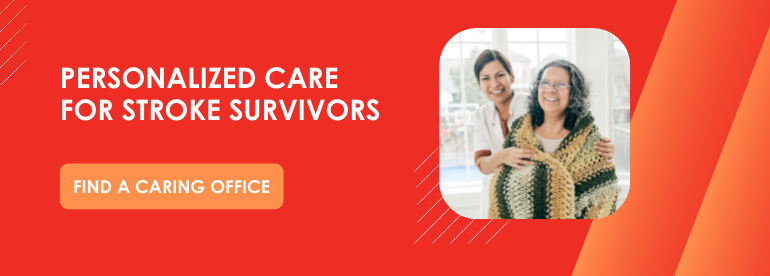Strokes are the leading cause of long-term disability among seniors, but most of them can be prevented by living a healthy lifestyle. Luckily, you can start working towards a healthier you today and reduce your risk of stroke — regardless of your age or family history. In this post, we will review some healthy habits you can start implementing now to help you manage your stroke risk.
Reduce Sodium Intake
Too much salt can increase your risk of high blood pressure, heart disease, and stroke. High blood pressure is one of the main risk factors for a stroke because it can damage blood vessels overtime, increasing the chance that a blood vessel in the brain bursts and causes a stroke.
Here are some suggestions from the American Heart Association on you can reduce sodium:
- Cutdown on the amount of salt you add to your meals, and watch your portion sizes.
- Look for “low sodium” or “reduced sodium” products at the grocery store.
- Read the nutrition labels for pre-packaged foods and review the amount of sodium per serving.
- If you’re looking for a flavor boost to substitute for your salt, turn to herbs, citrus, onion, garlic, or seasonings that don’t have sodium.
- Add foods with potassium to your meal to counter-balance the effects of sodium. Foods high in potassium include sweet potatoes, greens, tomatoes, bananas, and cantaloupe.
- Watch out for foods that have been pickled, brined, cured, smoked, or barbecued. These forms of preparing food often involve a lot of salt. Instead, try steaming, baking, grilling, poaching, or roasting.
Stop Smoking
If you currently smoke, take measures to stop. Smoking can lead to a number of health complications, including stroke. Smoke can cause your blood to become thicker and increases the plaque in your arteries, which increases the risk of a blood clot that obstructs blood flow to the brain.
Luckily, there are many things that can help you break this addictive habit. Start by talking with your doctor to identify the best approach for you to stop smoking. You may want to use the help of patches or other aids to help you reduce the urge to smoke. A support group can also give you the motivation that you need to leave smoking behind for good. Whatever you do, keep working toward your goal to quit smoking — don’t give up!
If you don’t smoke, you should avoid second-hand smoke, which can also damage your health. Encourage loved ones to quit smoking and don’t linger in areas where there is a lot of second-hand smoke present.
Exercise
Regular exercise is a great way to combat several stroke risk factors, including high blood pressure, diabetes, obesity, and high cholesterol. Try to get about 30 minutes of moderate exercise 5 times a week. Moderate exercises should get your heart rate up and cause you to breathe hard. If you aren’t able to exercise for 30 minutes at once, you can break it up into 15-minute or even 10-minute exercise sessions throughout the day.
Here are some of our resources to get started with an exercise routine:
- Best Exercise Equipment
- Creating a Safe Exercise Routine
- Exercise Wearables
- Balance Exercises
- Low-Impact Exercises
Of course, if you have existing health conditions that might keep you from regular exercise, make sure you talk with your doctor about what you can do to stay active.
Eat Fresh Fruits & Veggies
Eating more fresh fruits and vegetables can help you maintain a healthy diet. Fresh produce is low in fat and high in fiber. When choosing your fruits and vegetables, pick ones that have rich color — like spinach. These are often more packed with nutrients. Pair your produce with whole grains, lean protein, and low-fat dairy products for a well-rounded meal.
By sticking to a healthy diet, you can control some stroke risk factors, like high blood pressure, obesity, and high cholesterol.
Manage Your Existing Health Conditions
Another thing you can do to remain healthy and prevent stroke is to appropriately manage any existing health conditions. Follow your doctor’s orders and take prescription medications as directed. Whether it’s diabetes or arthritis, keeping your body as healthy as possible can help you reduce your risk of stroke.
Make sure you attend your regular physical examinations. Some health conditions that can contribute to your stroke risk, like atrial fibrillation, can be diagnosed only by a medical professional.
Talk with your doctor about your unique health situation and work together to manage symptoms from underlying conditions. If you develop new symptoms, see your doctor sooner rather than later so that you can effectively take care of your health.
Cut Down on Alcohol
Drinking too much alcohol can lead to high blood pressure or even trigger atrial fibrillation, which are risk factors of stroke. Additionally, alcoholic drinks are often high in calories and low in any nutritional value, potentially contributing to weight gain.
Of course, you don’t have to cut out alcohol altogether — just reduce your intake to about one drink in a day. Remember that different types of drinks have varying levels of alcohol, so it’s also important to watch your portions when getting yourself a drink.
Decrease Your Stress Levels
Chronic stress can actually harm your physical health. You might get headaches, have trouble sleeping, or experience digestive issues. Over time, stress could also lead to heart disease, high blood pressure, or diabetes. So, reducing your stress can be extremely beneficial to your overall health, while also helping to prevent a stroke.
Here are some tips to relaxing and reducing stress:
- Exercise
- Talk to a therapist
- Do something relaxing (like take a bath, breathing exercises, etc.)
- Join a support group
- Set healthy, realistic goals
- Pay attention to your body’s response to stress
- Try supplements or medication
- Reduce caffeine
- Write in a journal
You can also check out our blog post: 3 Easy Exercises to Relieve Stress.


